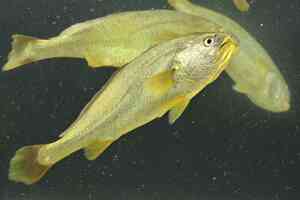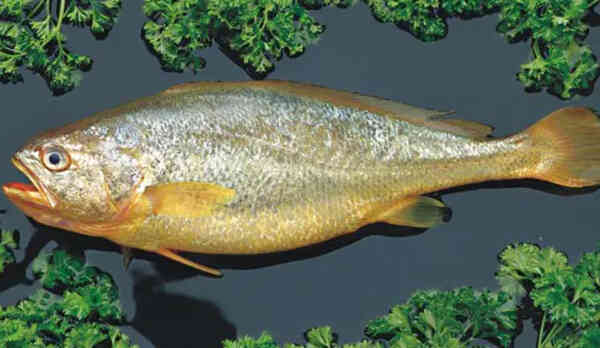
Alias Larimichthys crocea,Yellow croaker, yellow croaker, cucumber fish, golden dragon, big fresh, golden dragon, red melon, sweet-scented osmanthus yellow croaker, king fish, large yellow croaker
Family Perciformes Sciaenidae Y.croaker
Pseudosciaena crocea is a warm and humid nearshore migratory fish. It often lives in the middle and lower layers of water within 60 meters. It likes turbid waters. It often floats at dawn, dusk or high tide, and sinks during daytime and low tide. It has the habit of swarming. In the reproductive season, it swims from the open sea to the nearshore in groups, forming a fishing season. The fishing season is divided into spring and autumn. The spring season is generally from April to June. The fishing grounds are concentrated in the spawning areas near the coast of Jiangsu, Zhejiang and Fujian. The yellow croaker entering the Yangtze River estuary and adjacent sea areas mainly spawns and fishes in the Dazaiyang and Daiquyang. The spawning parents seek cakes in the nearby sea area of 30 to 40 meters. In October, they gradually turn to the deeper waters of the open sea to hibernate. The autumn season is formed in the northern Zhejiang sea area between September and October.

Yellow croaker is very sensitive to the threat of sound, and also has the ability to make strong sounds. Especially in the reproductive season, male fish will make "cluck" and "woooo" sounds, and female fish will make "hum" sounds all day long. When the fish are densely packed, the sound they make is like the boiling sound of water and the sound of pine waves, which is rare among fish. Yellow croaker grows fast.
Large yellow croaker is a predatory species, feeding on species such as clams, crustaceans, cephalopods, hydroids, polychaetes, chaetognaths, gastropods, cirripedes, branchiopods, lobateri, sphenopods, urochordae and diatoms. The average feeding rate of larvae (3 mm in length) is 68.9%, mainly feeding on zooplankton such as small daphnia, Japanese big-eyed sword daphnia, krill larvae and polychaete sea larvae. The average feeding rate of juveniles (6-16 mm in length) is 93.9%, mainly feeding on small daphnia, middle-sized daphnia, white pottery arrow worms, cirripede larvae, krill larvae, spiny shrimp, Japanese big-eyed sword daphnia and polychaete larvae. The average feeding rate of juvenile fish (16-200 mm in length) is 93%, mainly feeding on Chinese pseudo-euphausia, Chinese Daphnia, slender crayfish, Chinese whip shrimp, mantis shrimp and seven-star fish. The average feeding rate of adult fish (over 200 mm in length) is 55.6-97.0%, mainly feeding on crustaceans, followed by cephalopods and hydroids.
Yellow croaker was once an important economic fish species in China's oceans. Historically, it was listed as one of the four major marine fisheries with small yellow croaker, hairtail and cuttlefish. The fishing operations include mass purse seine, strewn net, drift net and fishing; machine wheel trawling and purse seine, etc. In 1974, the output reached more than 200,000 tons. However, due to the development of knocking boat fisheries in the 1950s, the fishing of unspawned broodstock in the 1960s and 1970s, the overuse of wintering grounds and the fishing of juvenile fish, its resources declined rapidly. In 2000, the output in the East China Sea was only 9,035 tons, and Guanjingyang, Maotouyang and Damuyang could not form fishing seasons. The age composition of yellow croaker is complex, with the highest age reaching 30 years old. It is difficult to recover after the resources are damaged.
Yellow croaker has high economic value, tender meat, rich in protein, and is a good fresh food. It is not only sold fresh, canned and processed into "melon-raised dried fish" and "yellow croaker dried fish", but also can be used in a comprehensive way. Fish maw can be dried and made into precious food "fish belly", and can also be made into yellow croaker glue, which is the raw material of industrial high-grade adhesives. Yellow croaker has certain medicinal value and is the raw material of some Chinese and Western medicines. Fish maw is fried, refined and roasted to make the traditional Chinese medicine "fish maw glue beads" which can treat peptic ulcers, kidney stones, etc. Otoliths are ground into powder and combined with other traditional Chinese medicines to make "fish brain stone powder", which has a good effect on the treatment of sinusitis.